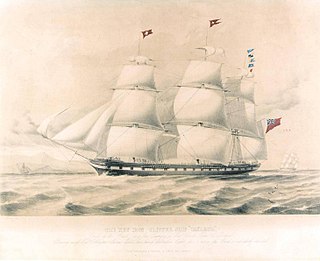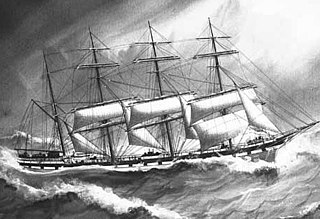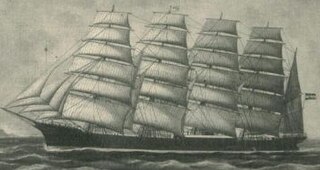Sarah Anderson was a British barque built in Liverpool in 1865. The ship was wrecked on 17 October 1886 en route from Coquimbo, Chile to Fleetwood, Lancashire when it ran aground on rocks near Trebarwith Strand, Cornwall.
Sarah Anderson was built in 1885 by the company Thomas Royden and Sons of Liverpool. The ship had three masts and an iron hull, measured 52.7 m long and weighed 589 tons. The crew of eleven was returning from Chile with a cargo of ore. The ship put in at Falmouth, Cornwall to await orders before leaving for Fleetwood on 13 October 1886. Aside from the sailors, there were four passengers; a woman and her two children who boarded in Chile, as well as the captain’s wife. [1]
The ship was caught in a fierce storm on 17 October 1886 and began to drift towards the north coast of Cornwall. Each day, Captain William Pucksey held short church services on deck and the crew was observed praying on the poop deck on the morning of the wreck. As the storm worsened, the crew cut away the masts and cast the anchors in an attempt to save the ship. Meanwhile the Port Isaac lifeboat tried unsuccessfully for several hours to reach them. As the ship was over 300 m from shore, every attempt to reach it with rocket-fired breeches buoy also failed. Just before midday, the ship struck Otterham Rocks, a stack also known as Gull Rock. There appeared to be an explosion as the deck of the ship blew up, sending a great spout of water into the air. The ship then foundered and disappeared beneath the water, killing all on board. [2]

RMS Tayleur was a full-rigged iron clipper ship chartered by the White Star Line. She was large, fast and technically advanced. She ran aground off Lambay Island and sank, on her maiden voyage, in 1854. Of more than 650 aboard, only 280 survived. She has been described as "the first Titanic".

SS Atlantic was a transatlantic ocean liner of the White Star Line that operated between Liverpool, United Kingdom, and New York City, United States. During the ship's 19th voyage, on 1 April 1873, she struck rocks and sank off the coast of Nova Scotia, Canada, killing at least 535 people. It remained the deadliest civilian maritime disaster in the North Atlantic Ocean until the sinking of SS La Bourgogne on 2 July 1898 and the greatest disaster for the White Star Line prior to the loss of Titanic in April 1912.

SS Schiller was a 3,421 ton German ocean liner, one of the largest vessels of her time. Launched in 1873, she plied her trade across the Atlantic Ocean, carrying passengers between New York and Hamburg for the German Transatlantic Steam Navigation Line. She became notorious on 7 May 1875, while operating on her normal route, when she hit the Retarrier Ledges in the Isles of Scilly, causing her to sink with the loss of most of her crew and passengers, totalling 335 fatalities.

The Royal Charter was a steam clipper which was wrecked off the beach of Porth Helaeth in Dulas Bay on the northeast coast of Anglesey, Wales on 26 October 1859. About 450 lives were lost, the highest death toll of any shipwreck on the Welsh coast. The precise number of dead is uncertain as the complete passenger list was lost in the wreck, although an incomplete list is retained in the Victorian Archives Centre in Victoria, Australia. The Royal Charter was the most prominent among about 200 ships wrecked by the Royal Charter Storm.

Thomas W. Lawson was a seven-masted, steel-hulled schooner built for the Pacific trade, but used primarily to haul coal and oil along the East Coast of the United States. Named for copper baron Thomas W. Lawson, a Boston millionaire, stock-broker, book author, and president of the Boston Bay State Gas Co., she was launched in 1902 as the largest schooner and largest sailing vessel without an auxiliary engine ever built.
Boyne was a 1,403 ton, Nourse Line sailing ship that T.R. Oswald of Southampton built in 1877. She was referred to as the "Hoodoo Ship" for the number of mishaps that occurred to her. She wrecked in 1886.

Preussen (PROY-sin) was a German steel-hulled, five-masted, ship-rigged sailing ship built in 1902 for the F. Laeisz shipping company and named after the German state and kingdom of Prussia. It was the world's only ship of this class with five masts, carrying six square sails on each mast.

Dundonald was a British four-masted steel barque measuring 2,205 gross register tons launched in Belfast in 1891. It was involved in a wreck in 1907 in the New Zealand Subantarctic Islands. Only 15 of its 28 crew survived; they were rescued seven months later by a scientific expedition.

Potosi was a five-masted steel barque built in 1895 by Joh. C. Tecklenborg ship yard in Geestemünde, Germany, for the sailing ship company F. Laeisz as a trading vessel. Its primary purpose was as a "nitrate clipper" collecting guano in South America for use in chemical companies in Germany. As its shipping route was between Germany and Chile, it was designed to be capable of withstanding the rough weather encountered around Cape Horn.

Marlborough was an iron-built two-decked merchant sailing ship which disappeared in 1890. She was built by the firm of Robert Duncan and Co., Port Glasgow and launched in 1876 for her owner John Leslie, who later sold her to the Albion Line. Marlborough disappeared during a voyage in January 1890, and has not been seen or heard from in over a century. Searches and investigations have yielded nothing conclusive, and the ship's ultimate fate, and that of her crew, remains unknown.

The SS Mohegan was a steamer which sank off the coast of the Lizard Peninsula, Cornwall, on her second voyage. She hit The Manacles on 14 October 1898 with the loss of 106 out of 197 on board.

The Halsewell was an East Indiaman that was wrecked on 6 January 1786 at the start of a voyage from London to Madras. She lost her masts in a violent storm in the English Channel, and was driven onto the rocks below a cliff on the Isle of Purbeck in Dorset, England. The vicar of nearby Worth Matravers recorded the event in his parish register:
On the 4th, 5th and 6th day of January, a remarkable snow storm, sometimes a hurricane, with the wind at south. On the latter day, at two in the morning, the Halsewell East Indiaman, 758-tons burthen, commanded by Captain Richard Pierce, bound for Bengal, was lost in the rocks between Seacombe and Winspit quarries in this parish. Never did happen so complete a wreck. The ship long before day-break was shattered to pieces...

Estrella de Chile was an iron three-masted barque of the Glen Line built to ply the route between Glasgow, Liverpool, and Chile via Cape Horn. The ship was wrecked in the Solway Firth on 25 November 1888 after getting into difficulties when the master misjudged the ship's position. The first mate drowned, but the rest of the crew were rescued by a lifeboat.
The Pomona was a fast packet clipper ship constructed in 1856 for Howland and Frothingham. She operated for just over two and a half years transporting emigrants and cargo from Liverpool, England to New York City. Pomona sank in the early morning of April 28, 1859 after a navigation error caused the ship to strike the Irish coast. 424 of the 448 people onboard died.
FV Commandant Bultinck was a Belgian Trawler that ran aground in a storm off Fleetwood, Lancashire, United Kingdom on 2 October 1929.